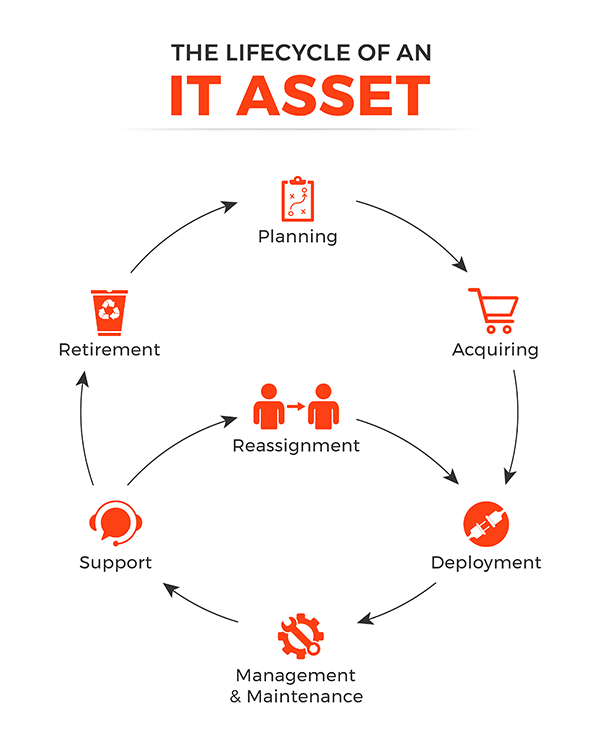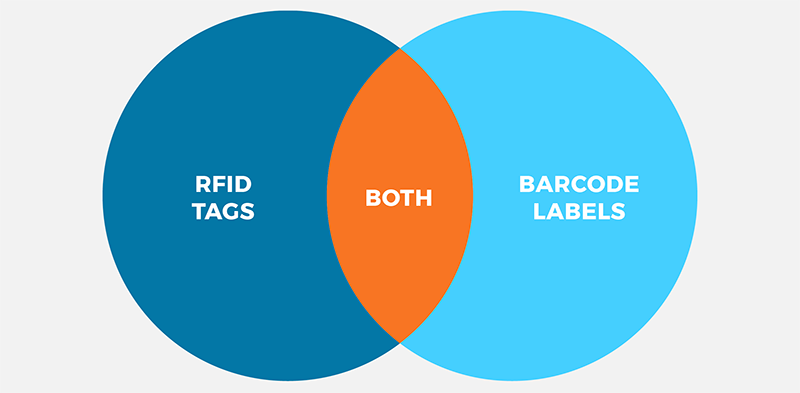RFID IT Asset Management – The Goals of ITAM
What are IT Assets?
Information Technology, or IT, refers to anything related to computing technology like hardware, software, networking, the Internet, or equipment. IT Assets are any items of value owned by a company that relate to IT, such as servers, computers, mobile devices, tablets, cabling, or routers. Most companies have a number of IT Assets that vary in cost from a few hundred to hundreds of thousands of dollars.

IT Assets are classified as assets instead of inventory items because they are not for sale, nor do they deplete. Most IT Assets have a lifespan of at least a few years, depending on the asset, and a somewhat predictable lifecycle as well. While the exact steps of each IT asset’s lifecycle can differ, the general consensus is that there are 6 main steps: Planning, Acquiring, Deploying, Managing/Maintenance, Support, and Retiring, and one additional step that occurs depending on the environment and cost of the asset - Reassignment.

IT Asset Management
Managing hundreds of IT Assets within a company is not easy due to typical asset mobility. Most IT Assets require continual maintenance, upgrades, support, and license updates, so it makes sense to ask – how can you monitor each piece of equipment or software and ensure it is where it is supposed to be, secure, up-to-date, and performing efficiently? The answer is by implementing an IT Asset Management system. A system for effectively managing IT Assets can save companies hundreds or thousands of dollars on the low-end, and upwards of tens or hundreds of thousands of dollars on the high-end, because of the high costs of IT Assets and the potential damage that could occur from a security breach.
IT Asset Management, also called ITAM, is a concept that has seen undeniable results in thousands of companies, and for that reason, has a worldwide professional association - IAITAM. IAITAM, or the International Association of IT Asset Managers, consists of individuals or organizations that research strategies, build training programs, and work toward centralizing IT Asset Management practices. IAITAM offers training courses, expert knowledge guides, and 7 unique ITAM certifications, which include: Certified Asset Management Professional, Certified Hardware Asset Management Professional, Certification in IT Asset Disposition, Certified Asset Management Security Expert, Certified Mobile Asset Manager, Certified Software Asset Manager, and Certified IT Asset Manager.
ITAM has five standards created by the Internal Standards Organizations, or ISO. These five standards create the framework and standards for data and vocabulary frequently used in the industry.
- ISO/IEC 19770-1 is a process framework to enable an organization to incorporate ITAM processes and policies sufficient to satisfy corporate governance requirements and ensure effective support for IT service management overall.
- ISO/IEC 19770-2 provides an ITAM data standard for software identification tags (“SWID”).
- ISO/IEC 19770-3 provides an ITAM data standard for the details of software entitlements, including usage rights, limitations and metrics (“ENT”).
- ISO/IEC 19770-4 provides an ITAM data standard for Resource Utilization Measurement (“RUM”)
- ISO/IEC 19770-5 provides an overview of the standards and vocabulary and is a free standard.
See the full size infographic here, and scroll to the bottom for the downloadable version.
IT Asset Management Systems
The broader goal of an ITAM system is to effectively manage a company’s ecosystem of IT Assets, but additional benefits can be gained by deploying this type of solution. When set up effectively, an ITAM system can provide visibility and prevent inefficiencies.
Benefits
Enables:
- Unique identification of each individual asset
- Informed decision-making for future growth planning
- Monitoring of individual assets (i.e. last read location) [RFID only]
- Location of lost IT Assets within a facility [RFID only]
- Quick and efficient inventories and audits [Barcode & RFID only]
Creates:
- Records for individual assets (i.e. purchase date, personnel assignments, maintenance records, etc.)
- A chain of custody for each asset in case it is lost or stolen
- Alerts to perform preventative maintenance
- IT Asset lifespan averages for the company
- Up-to-date records of available assets for new employees
Prevents:
- Working with Outdated Equipment
- Expired licenses in key software products
- Paying for licenses or subscriptions that are no longer used
- Replacing equipment that simply needs routine maintenance [or] Shortened IT asset lifespans
- Theft of monitored IT Assets [RFID only]
Components of an IT Asset Management System
IT Asset Management Systems vary depending on the extent of functionality needed. The type of software, tags, and hardware used will depend on a company’s goals, but there are two common ways to identify and manage IT Assets – barcode labels and RFID tags.
Tags/Labels
Tags or labels applied to each IT Asset uniquely identify one asset from another. If an asset is not uniquely identified, records and data pertaining to its activity and maintenance cannot be properly managed.
Barcodes are an efficient way to keep records and manage equipment, but they lack the tracking and monitoring capabilities that RFID tags can provide. When choosing a tag to place on an IT Asset, take in consideration the type of tag and the wear and tear that the device will experience over its lifetime. Below are a few considerations for choosing the ideal tag or label.
Type of Tag/Label

RFID Tag - Readable up to 20+ feet away, enables quick inventorying, locating abilities within an area, and automation of read data upon entering/leaving premises.
Both Barcodes & RFID Tags - Cost effective; integrable with many types of software; Size, branding, visual identification, and adhesive options.
Barcode Label - Able to be scanned from up to several feet away; generally cheaper per label.
Tag/Label Considerations
- Slim & Discrete - bulky tags can easily be knocked off an asset that is used daily.
- Waterproof & Dirt-Proof - a tag that is resistant to germs, dirt, or even spilled water that can occur sometimes in the workplace.
- Branding – a company-branded IT Asset tag can increase the odds that the asset be returned in case it is found after being lost or stolen from of the workplace.
- Size Options - IT Assets range in shapes and sizes; if a phone is tagged with the same IT Asset tag that is applied to a laptop, the tag may be too large and interfere with the phone’s use.
- Permanent Adhesion - using tags with permanent adhesion that are tamper-evident (and may even damage the asset upon attempted removal) decreases the chance the asset will be stolen,.
Hardware
The type and amount of hardware depends on whether an RFID system or a barcode system is selected. Scanning a tag and recording data can be accomplished using a mobile handheld RFID reader or barcode scanner. If RFID is selected, the same mobile RFID reader can inventory assets in certain areas and enable Geiger Counter-type functionality to locate an asset within a facility.
In order to monitor IT Assets leaving/entering a building, an RFID portal can be setup at the entrance/exit to scan and record timestamps. Additional information, like whether an IT Asset is entering or exiting, can be determined by setting up the system with the right hardware. Software can then use an algorithm to assign the asset as “in” or “out”.
Software
Deciding to create a custom piece of software or use an existing solution depends on capabilities, availability, and cost. Capabilities range widely from basics like scanning assets and recording data, to comprehensive functionality like managing support tickets, purchase requests, or creating custom analytics of a company’s current IT ecosystem. Before choosing a software to manage your IT Assets, decide which capabilities your company needs, research available solutions on the market, and determine cost feasibility.
ITAM Results

Case Study #1
Who: ALOG Data Centers of Brazil
What: Data Center that manages computing environments
Key Results: Cut number of lost assets by 89%, Cut inventory time by 98%
ALOG’s four massive data centers in Brazil can store up to 100,000 servers, and all were previously managed by barcode labels and manual processes. Because of the security regulations for data centers, inventory counts are required every three months. The company began to realize that this management style was becoming too time intensive and prone to frequent errors. In order to cut down labor costs, inventory time, and costs associated with replacing lost assets, they changed their barcode-based IT Asset Management System to an RFID-based system. By changing from manual inventory counts to automated counts with RFID, ALOG reduced errors and loss, and were able to receive and analyze actionable data about each IT Assets’ lifespan and cycle.
Read Confidex’s Full Case Study Here
Case Study #2
Who: Langley Aeronautical Research Center of NASA
What: Dedicated to Aeronautical research and testing new space hardware
Key Results: Cut inventory time by 80%, Increased Inventory Accuracy to 100%, ROI achieved in only 18 months
Data center assets are critical for a research facility like NASA’s Center in Langley and are extremely expensive to replace if lost or stolen. NASA was previously using a barcode ITAM System, but due to the high mobility of their IT assets, reported costly inventory times that were largely inaccurate. Inventory inaccuracies lead to spending thousands replacing high-dollar IT equipment that it thought to be lost. Because some of the IT assets moved frequently between field locations, NASA decided to switch to a more automated approach by installing an RFID solution using UHF RFID tags. Not only was inventory time drastically cut, but accuracy was improved to 100%, and the new solution provided visibility for reporting and data analysis.
Conclusion
Read Omni-ID’s Full Case Study Here, and click below to view or download the entire ITAM graphic.
For more information on IT Asset Management and IT Asset Management Systems with RFID, comment below or contact us!
If you would like to learn more about all things RFID, check out our website, our YouTube channel.
To learn more about RFID Asset Management, check out the links below!

